BAY St. Thomas with its botanical name Pimenta dioica, also called „Allspice“ – belongs to the Myrtaceae plant family. The natives of Central America used the tree not only as a medicinal plant but also to embalm their dead. Allspice was originally used as medicine in the tropical forests of South and Central America, also southern Mexico and the West Indies. Today, Allspice is cultivated commercially in Mexico, Honduras, Trinidad, Cuba, and Jamaica. The spice is also obtained from the fruits of a similar species, Pimenta racemosa, also found in Central America. Jamaica is today the leading producer of Allspice, known for its special exceptional quality, richer in essential oils than those qualities from other Caribbean islands or Central America. Today one can find Pimenta trees all around the world. Bay St. Thomas was introduced to Europe as a spice at the very beginning of the 17th century. It became quickly known also as a food preservative. The preserving properties of the plant allow making even fish and meat durable. In the culinary area, it is popular for centuries to spice soups, vegetables, and other dishes.
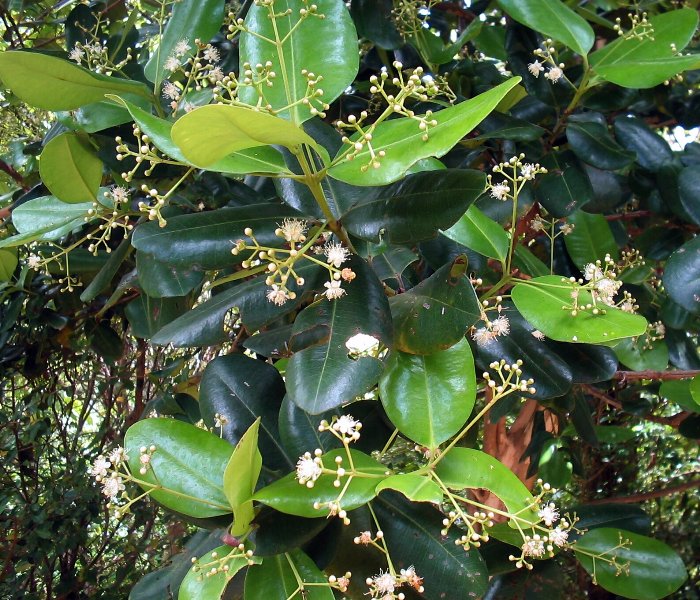
Bay St. Thomas leaves and blossoms
The sturdy Bay tree is evergreen and grows to about 10 metres high carrying long aromatic lance-shaped leathery leaves. It is not demanding to soil and prefers the climate of the Caribbean Islands where it prospers best.
The essential oil is obtained through steam distillation of the leaves from trees being at least five years old. It is golden, yellow in colour. The aroma can be described as medicinal, fruity, spicy, balsamic, and herbaceous, somehow similar to the scent of Cloves, only gentler. It blends well with Benzoin, Bergamot, Black Pepper, Cardamom, Cinnamon Leaf, Clove bud, Coriander, Frankincense, Geranium, Ginger, Grapefruit, Lavender, Lemon, Nutmeg, Petitgrain, Rosemary, Sandalwood, Sweet Orange, Ylang Ylang and others.
For aromatizing rooms and stimulating creativity one can blend:
- 1 drop Bay,
- 2 drops Grapefruit,
- 1 drop Ylang Ylang,
- 2 drops Cardamom,
- 2 drops Atlas Cedar
– just as an example.
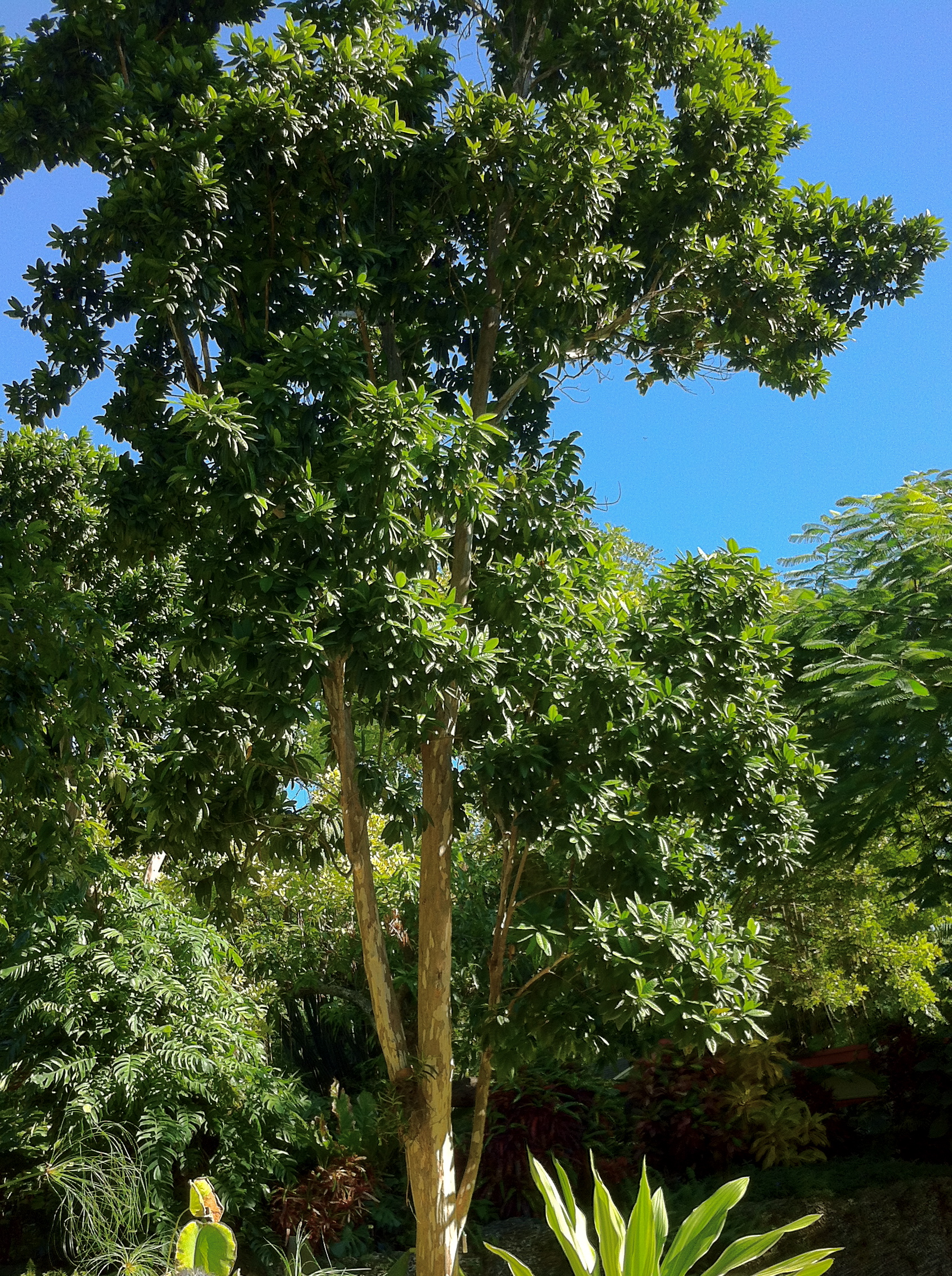
Bay St Thomas (Pimenta dioica)
Beautiful therapeutic properties
Allspice has a wide range of uses. In common usage, it is a strongly stimulant spice with a very fiery taste. In Ayurvedic medicine, we would say it boosts up the AGNI, the digestive fire in us. In the ethnomedicinal field, the oil has been used as an anaesthetic, carminative, stimulant, anti-diarrhoeal, and anti-dysenteric, also as a tonifying and revitalizing agent. The main chemical components of the oil among others include Eugenol, Myrcene, Chavicol, Methyl Eugenol, Linalool and Limonene, 1,8 cineole. The therapeutic properties are digestive, anti-septic, anti-microbial, analgesic, anti-neuralgic, antispasmodic, astringent, expectorant, insecticide, and tonifying.
Bay St. Thomas essential oil is blessed with a rich scale of physically healing properties. Eugenol, a powerful phenolic compound and one of the strongest anti-oxidants we know, can be marked as the main ingredient responsible for the relieving effects on muscle, bone, and nerve pains, rheumatic pains included. Warming for the muscles, it provides relief from soreness if overexertion caused the situation. Eugenol also is a powerful inhibitor of platelet activity. Therefore, those taking anticoagulants should use it with caution.
In case of respiratory complications due to a cold being the complaints Bay essential oil acts as an expectorant. Using the oil in a vaporizer and inhaling deeply for a few seconds it will help to loosen phlegm, which then can be coughed up and leave the body thereby cleaning the lungs. Furthermore, the oil acts as a strong stimulant for the immune system. Also, skin infections show a reduction.
The use of Allspice medicine is often marked by different cultural approaches:
„Costa Ricans are known to use Allspice to treat dyspepsia and diabetes. Guatemalans are known to apply crushed Allspice berries to bruises, sore joints, and for myalgia (muscle ache). In Cuban medicine, Allspice along with other herbal mixtures is used to relieve indigestion. Not only used in the areas where Allspice originated from but its use has also been incorporated in the Indian traditional medicine, the Ayurveda. Extracts of Pimenta leaves have hypotensive effects. Known as a folk remedy used for the treatment of high blood pressure, obesity, and digestion problems in Central America, as well as treatment for menstrual cramps, and abdominal pain in Caribbean culture…“
https://www.ncbi.nlm.nih.gov/pmc/articles/PMC3891794/

Bay St. Thomas berries
The Eugenol content in Allspice – as we have seen – has good effects on the digestive system, purifying, and clearing, confirmed by the popular traditional use of Allspice in the Caribbean countries. The oil also unfolds stress releasing qualities by calming an overworked mind and soothing exhausted nerves. On the other hand it shows animating, vitalizing and stamina strengthening characteristics.
The modern cosmetic industry adds the oil to many hair products such as tonics for men. By intensifying blood circulation in the scalp it is able to stimulate hair growth if balding and thinning scalp are the problem. It is also used to treat dandruff. The perfumery industry adds it also to „Eau de Toilette“ for men – and it is said to radiate a magnetism of attraction to women.
Anti-cancer activity of Bay St. Thomas
In the meantime, a number of research studies have shown the effect of Bay oil on cancer. In their lab research Amal A Al-Gendy, Fatma A. Moharram, and Mohamed A Zarka from Cairo, Giza and Zagzi universities in Egypt write – here on the oil from the flower of Allspice:
„Fifty-two components were identified by GLC-MS analysis of Pimenta racemosa flower oil where 1,8-cineole was the major components. The oil showed potential antioxidant activity compared with ascorbic acid. It also showed diagnostic activity against different human carcinoma cell lines and antimicrobial activities against bacteria and fungi. Pimenta racemosa flower oil could be a useful source of natural antioxidants and antimicrobial.“
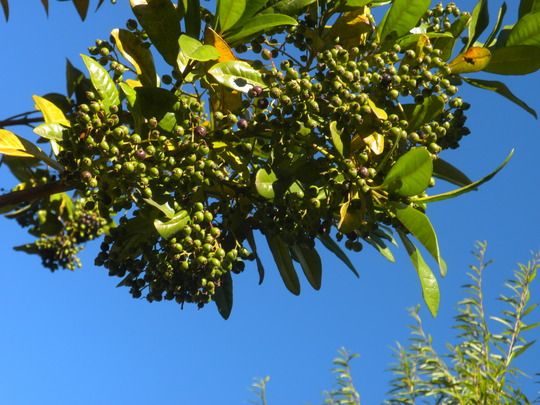
Bay St. Thomas branch with fruits
Or here :
„We have presented a critical evaluation of its medicinal properties with special attention as a chemo-dietary prevention agent for chronic diseases and malignant cancers. Several compounds abundantly found in Allspice, namely Quercetin, Gallic acid, and Ericifolin show both in vitro and in vivo antiproliferative and antitumor activities. Opportunities exist to identify several potential anticancer compounds from Allspice and test their bioavailability and mechanism of action on normal and tumor systems.“
https://www.ncbi.nlm.nih.gov/pmc/articles/PMC3891794/
„Bioactive compounds from edible plants have limited efficacy in treating advanced cancers, but they have the potential to increase the efficacy of chemotherapy drugs in a combined treatment. An aqueous extract of berries of Pimenta dioica (Allspice) shows promise as one such candidate for combination therapy or chemoprevention. An aqueous extract of Allspice (AAE) was tested against human breast cancer (BrCa) cells in vitro and in vivo. AAE reduced the viability and clonogenic growth of several types of BrCa cells (IC50 ? 100 ?g/ml)“
https://pubmed.ncbi.nlm.nih.gov/25945840/
„The compound, Eugenol 5-O-?-(6′-galloylglucopyranoside) or Ericifolin (EF), showed anti-proliferative, pro-apoptosis and anti-AR transcription activities. These results demonstrate a potential use of AAE and EF against prostate cancer.“
https://pubmed.ncbi.nlm.nih.gov/23568956/
„In the study published online May 8 in the Oxford Journals’ Carcinogenesis and led by Bal L. Lokeshwar, Ph.D., professor of urology and radiation oncology and Co-Director of Research in the Department of Urology, researchers demonstrated that Ericifolin, a complex compound in the allspice berry, significantly slows the growth of prostate cancer tumors by suppressing the androgen receptor (AR). A molecule central to the growth and metastasis of prostate cancer, AR enables prostate cancer cells to survive even after hormone therapy, which along with surgery and radiation is the standard treatment for prostate cancer.
Androgen receptor, or AR for short, is the principal drug target for the treatment of prostate cancer, but there is no drug that completely eliminates AR. This complex compound in allspice seems to do that, Lokeshwar said. “The most interesting data shows that it actually kills tumor cells which express the very specific prostate cancer marker, the androgen receptor. That is not to say that people should start eating allspice with every meal, but there exists the potential that the slow and steady consumption of this chemo-dietary agent may slow or even prevent prostate cancer.”
https://scienceblog.com/63595/prostate-cancer-fighting-compound- found-in-jamaican-allspice/
Anti-microbial activity of Bay St. Thomas
Also, the anti-microbial effects of the essential oil of Bay St. Thomas have been proven and shown in numerous cases stronger effects than standard allopathic drugs as can be seen here in the chart below published in the „Journal of Pharmacognosy and Phytochemistry“ by the 3 above-mentioned scientists.
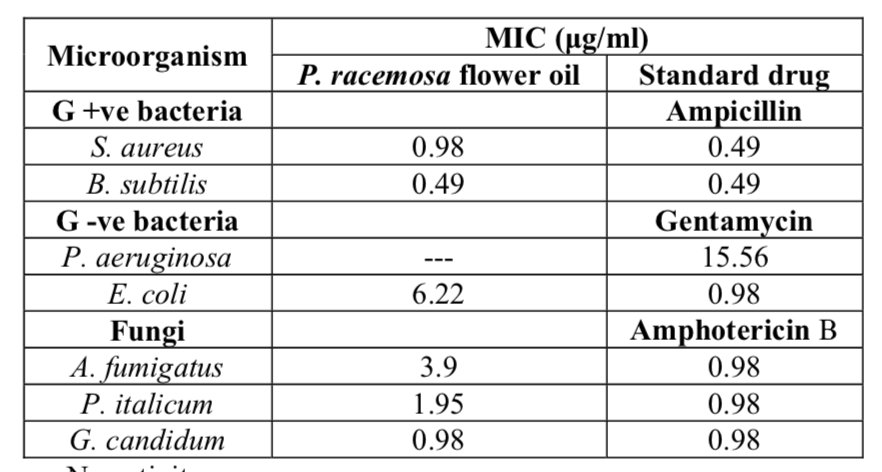
Also, what is interesting, next to their remark on the anti-microbial and anti-fungal effect of Pimenta oil, their remark on the synergistic effect of the oil’s biochemical compounds – a phenomenon which cannot be emphasized enough today given the „crazy hunting“ for single compounds in modern pharma-industry. The researchers write here:
„Most of EO components identified in this study were reported to have antimicrobial action. 1,8-Cineole, terpinen-4-ol, linalool, and ?-terpineol exhibited significant inhibition of Staphylococcus aureus and Escherichia coli. Also, 1,8-cineole showed fungicidal activity against Aspergillus flavus and Aspergillus parasiticus. The different antibacterial activity of the EO, compared with those of their major components, can be attributed to the synergistic effect of the different components in the oil and/or by the presence of other active constituents in small concentrations.“
Journal of Pharmacognosy and Phytochemistry 2017; 6(2): 312-319
The same principle of compound synergism shows up here:
„To sum up, the biological properties of the Pimenta racemosa flower essential oil can be attributed to the complex mixtures of numerous molecules, compared to 1,8-cineole. This emphasizes the theory that natural products action is potentiated by synergism. In other words, the variation of concentrations and compositions within each EO is necessary for its action.“
http://www.phytojournal.com/archives/2017/vol6issue2/PartF/6-2-49- 620.pdf
Good for mind and soul
Pimenta oil unfolds stress-releasing qualities by calming an overworked mind and soothing exhausted nerves. Diluted in massage oil or added to bathwater together with Rose or Juniper essential oil it develops an overall relaxing and sedative effect on the physical, emotional and mental part of our consciousness. On the other hand, it shows animating, vitalizing, and stamina strengthening characteristics when applied in rather low doses whereas higher doses will tend to produce the above-mentioned quietening reactions, a fact proving its balancing and adaptive capabilities. Some ascribe euphoric reactions to the oil and indeed, it is able to increase our creativity and enrich our fantasy. Spiritually, it gives way to intuition and allows heart and mind to work in team spirit.
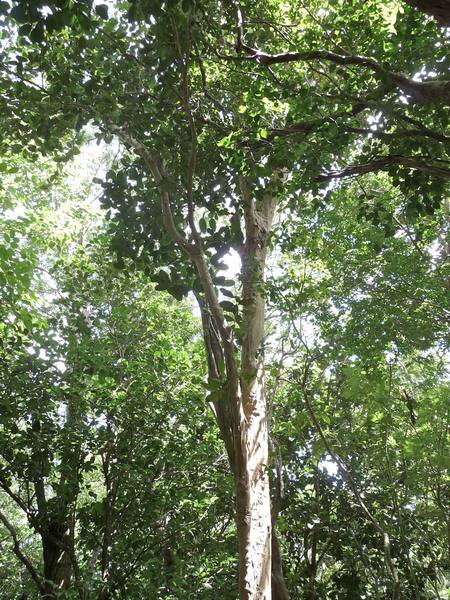
Bay St. Thomas tree